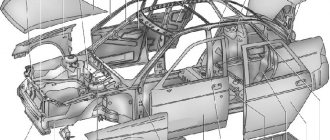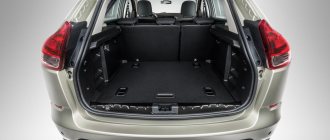Let's look at the technical parameters of Largus using the example of Largus Cross 5 seats, the release of which was a successful solution for driving on Russian roads. For more than two years, Lada Largus has occupied a confident position among station wagons on the Russian market. A domestically assembled car, created on the basis of the B0 platform of the French Renault Logan, attracts consumers with its simplicity, reliability and spaciousness. There is also a modification of this model with 7 passenger seats. Despite the fact that this model has been on the market for a long time, the demand for it remains high. For potential buyers, this article will discuss the technical characteristics of the Lada Largus 5 seats.
All about the trunk of the Lada Largus - volume, dimensions, features
LADA Largus has long won the sympathy of Russian car enthusiasts. Drivers often pay attention to the large trunk volume of the Lada Largus, which is considered the main advantage of this car. Domestic cars also cope well with another task - providing inexpensive and comfortable travel on modern roads. These two aspects and the ability to accommodate a large number of passengers allowed the car, produced at the Russian AvtoVAZ, to become a popular model in the CIS countries.
The dimensions of the Largus trunk depend on the body variation, it can be:
- station wagon;
- van;
- minivan.
Each car variation has its own luggage compartment volume. In a station wagon designed for 5 seats, the volume of this compartment is 700 liters. But the owner of this model can transport a large load. In the Lada Largus station wagon, the trunk volume can be increased to 1500–1800 liters by removing the second row of seats - a three-seater sofa. With the seats folded down, the station wagon's luggage compartment volume increases to 2,350 liters.
The Largus van has the largest trunk dimensions. In this variation of the car there is no back row of seats, and sometimes even two, and the body is elongated. Officially, the van's trunk capacity is 2,500 liters. The main task of the model is to transport goods, so there are no additional components or elements inside the body.
The van has a reinforced suspension, as this model is designed for transporting large cargo. Station wagons do not have this option.
Version for 7 seats
Now to the question of what the Lada Largus can offer us with 7 seats in the trunk.
This is a more practical car for those with a large family. There are 2 additional seats available here.
I can’t say that the last row is full, just like the second. Children and teenagers will feel comfortable here. Not every adult can fit in there. But overall it’s a good option. When you need to transport 6-7 people, it is not necessary to buy a minibus. You can get by with a budget domestic car like the Lada Largus.
An additional pair of seats allows you to transport 2 more people. But the 3rd row takes up some of the luggage space. As a result, only 135 liters remain in the cargo compartment.
Since the length of the Largus trunk does not change when folding the seats, lowering the 3rd row returns us the same 560 liters.
As you can see, the car does not lose capacity if you fold the third row. Yes, the height from floor to roof will be slightly smaller, but this does not greatly affect the capacity.
You can also omit the second row. Then the dimensions of the Largus trunk will be 2350 liters.
Another interesting thing is the length of the compartment if you omit only the 3rd row. Here it turns out to be 90 cm. The width and height of the opening are the same as in the case of the 5-seater configuration.
Cross
The smallest trunk size is in the Largus minivan, designed for 7 seats. The Largus Cross trunk reaches a volume of 200 liters. The manufacturer helped car owners by allowing them to increase the volume of the luggage compartment in liters to 1600–1800, for which two rows of seats should be removed.
The seven-seater version (minivan) has the most “modest” luggage compartment. But the manufacturer met his loyal customer halfway and endowed this modification with a simple secret: it is also possible to increase the luggage space to the same 1600–1800 liters by performing an identical operation to dismantle the stern seats. To do this, you will need to remove two planting rows.
Of course, neither a station wagon nor a minivan are designed to transport large loads, but if necessary, they will cope with this task perfectly.
Comparison with competitors
By its nature, Lada-Largus has few analogues on the Russian market and the CIS car market. This is largely due to the weak demand for the B-class in the post-Soviet space. Despite this, it is quite possible to highlight some parallels and compare a number of similar models in terms of cargo transportation.
First of all, we note that among the most popular competitors and analogues of the Lada-Largus in the CIS there are simply no such load-lifting models. Just think, but the brainchild of AvtoVAZ is capable of transporting up to 800 kilograms in its “van” variation and about 650 kilograms in the “station wagon” variations. None of Largus’ competitors can boast of such data. Moreover, on average, among car analogues, the load capacity ranges from 450 to 650 kilograms, which, frankly speaking, is not much.
In terms of capacity and overall size of the luggage compartment of the Lada-Largus, everything is not so rosy. Yes, the car is not a clear outsider in this regard, but it is not among the leaders either. A similar trend is clearly visible in the comparative table below:
For most car enthusiasts who have chosen the Lada Largus as their faithful road companion, practicality is usually a priority, and trunk volume plays an important role. Behind it are two global concepts related to providing such convenient options as:
- achieving comfortable movement when loaded on roads with different surfaces;
- getting a car that can surprise you with its carrying capacity and spaciousness of the luggage compartment.
In practice, many owners have verified that the Lada Largus fully complies with these two aspects. This allowed the universal “Russian” to capture the “hearts” of car enthusiasts not only in the domestic space, but also to prove itself in the market of the CIS member countries, because the trunk size is quite acceptable, and the car also has 5 seats.
In our material, we intend to highlight the features of the luggage compartment of this model in comparison with classmates, who are also competitors, and we will also clarify the size of the luggage compartment.
Luggage compartment dimensions
Based on the above, we can conclude that the dimensions of the luggage compartment of any version of the Lada Largus are quite impressive. The general dimensions of this compartment for the models are as follows:
- opening height is 920 mm;
- the opening width is 980 mm;
- the height of the luggage compartment to the ceiling is from 870 to 930 mm for universal models and up to 1000 mm for a van;
- trunk length is 480–1570 mm for station wagons up to the 3rd and 2nd row of seats;
- The length of the van's luggage compartment is 1800 mm to the dividing wall;
- luggage compartment width – 1000–1450 mm.
Internal dimensions of the cabin (luggage compartment)
The trunk volume of the Largus Station wagon directly depends on the number of installed rows of seats. In liters it will be accordingly: 135/560/2350
Load capacity may vary slightly depending on modification. Average - about 550 kg . (more precisely in the characteristics)
Dimensions of the cabin and luggage compartment (for transportation of long cargo)
The length of the cabin from the trunk door to the windshield in the area of the dashboard is 3 m. 14 cm . Distance from tailgate to dashboard
2 m. 70 cm . The diagonal size of the cabin (from corner to corner) is 3 m. 24 cm . The width of the cabin behind the front seats is 1 m 43 cm. The width of the cabin at the shoulder level of the third row passengers is about 1 m 29 cm . Distance from the tailgate threshold to the folded rear seat of the second row (it stands upright)
1.5 m (max 1.66 m) With the rear seat completely removed, the distance will increase by another 20 cm .
To transport long items, fold down the backrest of the second row and recline the backrest of the front passenger seat onto it. An extra-long weight can be rested with one end on the instrument panel, just be sure to place something soft so as not to scratch the plastic. And secure the length with a seat belt.
L1 - 910-1120mm, L2 - 590-790mm, H - 1310mm, H1 - 1080mm, H2 - 1020mm, B1 - 1380mm, B2 - 1405mm, L3 min/max - 1250/1700mm, B3 min - 1000mm, H3 - 475/ 1050mm, H4 - 920mm, Vbag . - 488 l.
Approximate internal dimensions of the luggage compartment Largus Station wagon
Internal dimensions of Largus Van
The internal volume of the serial Largus van is 2.54 m³.
Dimensions of the trunk door opening: height 92 cm, width 96 cm. Diagonal from the top corner to the wheel arch: 128 cm. Internal distance between the wheel arches 96 cm. Distance from the edge of the trunk to the partition: 194 cm.
Dimensions of doorways, trunk, hood, etc.
Video
Station wagon body and dimensions
The body of this car is not VAZ’s own design. Lada Largus 5 seats is a modified Largus model, which, in turn, received the appearance from the French car Renault Logan. This decision was made due to the fact that Logan has been going to Russia in recent years. Therefore, the B0 body platform, already well known to domestic consumers, was chosen as the foundation for the creation of Largus. Lada Largus Cross 5 seats - a modernized version with larger wheels for better off-road traction.
The cross version has the following dimensions:
- 4.47 m long;
- 1.756 m in width;
- 1,682 m high;
- ground clearance 0 17 m;
- the track width of the front wheels is 0.05 m less than the rear (1.461 m versus 1.466 m);
- trunk volume 560 liters.
The car is front-wheel drive, that is, the front pair of wheels is driving. The engine is located in front across the hood. The body structure is classic, proven over the years by Renault. The lines are straight, restrained, and there are neat transitions from one element of the exterior to another.
The ground clearance has been increased compared to the standard station wagon to ensure better cross-country ability on rough terrain. The trunk in the Largus station wagon for 5 seats has an impressive volume of 560 liters without folding the rear seats. When the passenger seats are folded, the trunk becomes many times larger and makes the Largus a full-fledged van. The boot mat for the Lada Largus is not included.
The Largus' curb weight is about 1.3 tons, and its total weight is about 1.75 tons.
Lada Largus van: cargo compartment volume, technical characteristics, body dimensions
On a regular Lada Largus van, the body dimensions are selected so that Euro pallets can be transported. We are talking not only about the space between the pillars, which are spaced 108 cm apart, but also about the distance between the wheel arches. It is 96 cm, and one pallet takes 80. The distance from the rear doors to the partition generally approaches two meters! A little more and it would have been possible to fit a couple of Euro pallets. Here we will look at how to remove the partition between the body and the cabin, and at the same time remove the inner bottom of the body. The first is needed for transporting long cargo, the second is also used for some reason.
We study the fastening of partitions and floors. Everything is shown in one video.
Unfasten the partition or part of it
The partition separating the body and the cabin consists of two halves. They can be removed separately. Both parts are screwed to the body with screws designed for a 13mm key size. Of course, you need a socket wrench.
Screws 1 were hidden under the casing
The four screws on the left and right are located on the cab side. And to unscrew them, remove the casing.
All actions with cladding
The left part of the septum is removed after the right. To remove only the left half, first remove both, and then mount the right sash back. Based on this, immediately decide where you will remove the trim - only on the right or on both sides.
The volume of the body on the Lada Largus van cannot be greatly increased, even if the partition is completely removed. But without the partition, by removing the seat, it will be possible to transport loads 3 meters long.
So, let's start dismantling the trim: you need to remove the seat belt (key “17”), and then unscrew one self-tapping screw. A Torx T20 wrench is suitable for the self-tapping screw.
Two parts “1” prevent the removal of casing “2”
It is necessary to unscrew all the parts numbered 1. And the casing will have to be removed, overcoming the resistance of the clamps.
Removing the partition
First, unscrew the four screws shown at the beginning of the chapter (key “13”). Then with the same key they go into the body.
All fasteners are the same
As you can see, both halves are held on three sides: top, bottom, middle. The number of screws will be as follows: four at the top and bottom, five at the seam between the sashes. Work order:
- Completely unscrew the four screws on top;
- While holding the nuts on the seam, unscrew the screws from the cabin side;
- The lower screws are unscrewed 2-3 turns. Then all parts are disengaged.
Let us remind you that the right wing can be removed separately. We wish you success.











